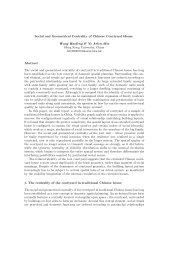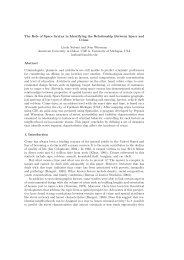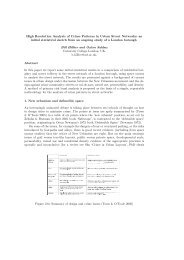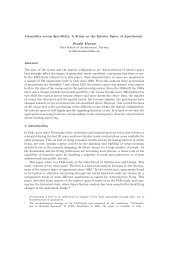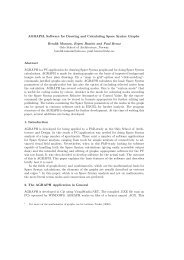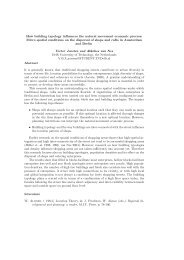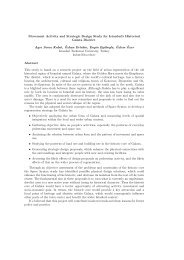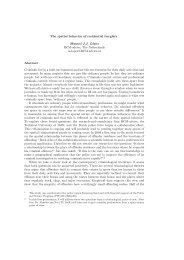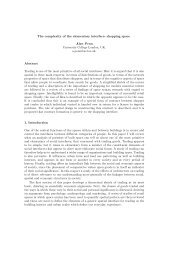Seen in a different light. Icons in Byzantine museums and churches ...
Seen in a different light. Icons in Byzantine museums and churches ...
Seen in a different light. Icons in Byzantine museums and churches ...
Create successful ePaper yourself
Turn your PDF publications into a flip-book with our unique Google optimized e-Paper software.
252 G. Stavroulaki <strong>and</strong> J. Peponis<br />
of <strong>light</strong> <strong>in</strong> a sample of <strong>churches</strong>, for example, Potamianos (2000) has argued that <strong>light</strong> was<br />
deliberately manipulated by designers. The dome br<strong>in</strong>gs the image of the almighty, which<br />
is typically pa<strong>in</strong>ted on it, <strong>in</strong>to greater illum<strong>in</strong>ation; the <strong>in</strong>tensity of <strong>light</strong>ly is gradually<br />
reduced as the gaze shifts downwards towards the depictions of episodes from the life of<br />
Christ, the evangelists <strong>and</strong> the sa<strong>in</strong>ts. While the image of the almighty was illum<strong>in</strong>ated<br />
consistently throughout the day other images were more transiently illum<strong>in</strong>ated over the<br />
course of the day, <strong>and</strong> <strong>in</strong> some cases over the course of the year. The variation of <strong>light</strong><strong>in</strong>g<br />
conditions <strong>and</strong> of consequent impressions accord<strong>in</strong>g to one’s position <strong>in</strong> the church was<br />
also recognized <strong>and</strong> seen as consistent with the notion that god is revealed <strong>in</strong> <strong>different</strong><br />
ways to <strong>different</strong> people.<br />
Thus, <strong>in</strong> the church, icons are arranged <strong>in</strong> a configuration which emerges accord<strong>in</strong>g to<br />
<strong>light</strong> <strong>and</strong> movement, they st<strong>and</strong> out <strong>and</strong> they recede <strong>in</strong>to the background accord<strong>in</strong>g to<br />
patterns which are the by product of the arrangement of space, they act as accentuations<br />
of space as well as objects of <strong>in</strong>terest <strong>in</strong> their own right. This configurational pattern <strong>and</strong><br />
its contrast to the pr<strong>in</strong>ciples of parataxis or collection mentioned earlier poses a number<br />
of methodological <strong>and</strong> theoretical questions which are the ma<strong>in</strong> topic of this paper.<br />
1. Spatial fields <strong>and</strong> the structure of po<strong>in</strong>ts of view<br />
The primary question to be addressed is the relationship between a po<strong>in</strong>t of view <strong>and</strong><br />
the spatial arrangement with<strong>in</strong> which it is def<strong>in</strong>ed. Should we simply th<strong>in</strong>k of spatial<br />
arrangements as <strong>in</strong>terrelated <strong>and</strong> <strong>in</strong>terdependent po<strong>in</strong>ts of view? From the perspective of<br />
space syntax it is tempt<strong>in</strong>g to give a positive answer. After all, when we take each node of<br />
a graph as a root <strong>and</strong> arrange other nodes along successive horizontal l<strong>in</strong>es accord<strong>in</strong>g to<br />
the number of transitions that are needed to reach them from the root (Hillier, 1996), a<br />
rather powerful theoretical idea is stated: a configuration can be def<strong>in</strong>ed as a set of <strong>different</strong><br />
relations between part <strong>and</strong> whole, so that the configuration “looks <strong>different</strong>” depend<strong>in</strong>g on<br />
“where one st<strong>and</strong>s”. In the st<strong>and</strong>ard practice of draw<strong>in</strong>g “justified graphs” the expression<br />
“looks <strong>different</strong>” applies literally to the representation, <strong>and</strong> more metaphorically to the<br />
reality be<strong>in</strong>g represented. Thus, the connectivity between spaces is only locally a matter of<br />
visual relationships; hence it is commonly affirmed that space syntax deals with topological<br />
rather than visual patterns. But if we take the visibility polygon rather than the convex<br />
space or the l<strong>in</strong>e of movement as a start<strong>in</strong>g po<strong>in</strong>t <strong>and</strong> if we analyze a visibility graph as a<br />
pattern of <strong>in</strong>tersect<strong>in</strong>g visibility polygons, can we not arrive at a more literal <strong>in</strong>terpretation<br />
of a configuration as <strong>in</strong>terdependent <strong>and</strong> <strong>different</strong>iated po<strong>in</strong>ts of view? We will suggest<br />
that such an approach would be only partially fruitful when we confront modes of spatial<br />
configuration such as the one presented <strong>in</strong> the relatively simple but <strong>in</strong>terest<strong>in</strong>g example<br />
of the Byzant<strong>in</strong>e Church. Consequently, we propose ways to augment it.<br />
Consistent with the arguments presented by Peponis, Karadima <strong>and</strong> Bafna (2003) <strong>and</strong><br />
by Stavroulaki <strong>and</strong> Peponis (2003), we will suggest that we should take layered rather<br />
than simple descriptions as the start<strong>in</strong>g po<strong>in</strong>t for deal<strong>in</strong>g with the relationship between<br />
spatial configuration <strong>and</strong> po<strong>in</strong>t of view. In practical terms, what this means is that any<br />
representation of a po<strong>in</strong>t of view, such as a visibility polygon or a section of a visibility<br />
polygon represent<strong>in</strong>g a visual cone, has to be set aga<strong>in</strong>st the background of several alternative<br />
representations of the spatial doma<strong>in</strong> under consideration. It is not sufficient to<br />
represent how visibility polygons <strong>in</strong>tersect each other with<strong>in</strong> a spatial doma<strong>in</strong>. We must<br />
also consider how they <strong>in</strong>tersect any number of relevant <strong>and</strong> overlapp<strong>in</strong>g fields that are


